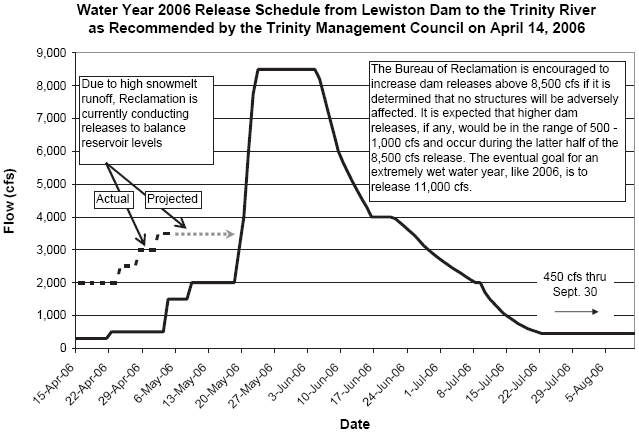
|
|

|
|
This year’s alternatives were originally developed by the TRRP’s Flow Schedule Work Group using Reclamation’s initial projections for a Wet water year. The Technical Modeling and Analysis Group (TMAG) and representatives of partner agencies conducted model runs for sediment transport, temperature conditions, and riparian recruitment for each alternative. Results were presented to the TMC on March 29, 2006, and after hearing comments from the Trinity Adaptive Management Working Group (TAMWG), they tentatively approved a recommended flow schedule. Recognizing that heavy rain and snow were likely to continue in coming weeks, the TMC made contingency plans in case the water year determination changed. This did occur, and on April 10, Reclamation officially classified the Trinity Basin as “Extremely Wet”. The Flow Schedule Work Group met again on April 11 to consider alternative schedules given this updated information. A key issue in this year’s flow scheduling process was how to best deal with the large volume of fine sediment deposited in the mainstem Trinity River below Lewiston dam during this past winter’s storms. Given that Extremely Wet water years are relatively infrequent (occurring about 12% of the time); the Flow Scheduling Work Group explored ways to transport the greatest volume of fine sediment possible with the available volume, while accomplishing as many other Extremely Wet water year management targets as possible. The approved schedule balances two key objectives: transporting fine sediment out of the system, while also potentially improving black cottonwood seed germination at the recently constructed Hocker Flat channel rehabilitation site. Additionally, incremental increases in peak flows above 8,500 cfs to further achieve geomorphic objectives will be implemented if prudent monitoring of adjacent floodplain structures indicates that higher flows could be accommodated. Although Reclamation approved a delay in the schedule to accommodate the opening weekend of trout season, the agency later found it necessary to release additional water over and above the recommended fishery restoration flows in order to maintain reservoir storage capacity given the unusually large snow pack this year. These conditions will also result in a full reservoir throughout much of the summer.
Return to the Trinity County RCD Home Page
|


